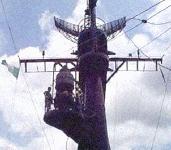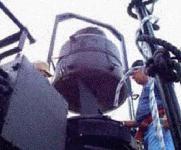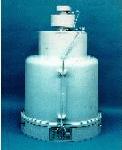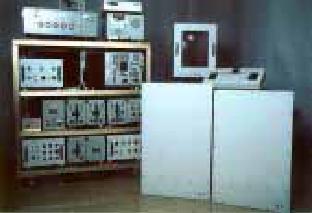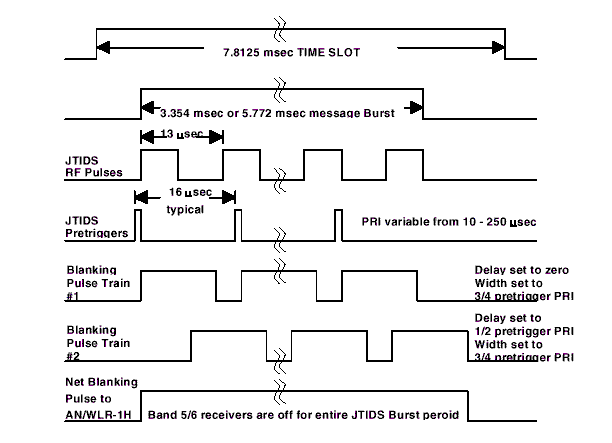



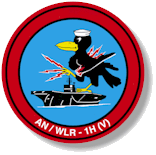 The WLR-1H (V)5 performs Over-The-Horizon Cued Detection, Classification and Targeting (OTH Cued DC&T) area surveillance and threat warning. The AN/WLR-1H(V)5 performs in mission roles of over-the-horizon cued detection, classification and targeting (OTH Cued DC&T) area surveillance and threat warning that covers frequencies of 0.5 Ghz to 18.0 Ghz. This latest configuration features a single package antenna to replace the original suite of
four antennas used with the (V)3 variant. The new suite offers improved reliability and a 500 lb reduction in high mast weight. Some of the performance specifications include simultaneous 6 band activity display and a semiautomatic look-up of emitter/platform. The AN/WLR-1H(V)5 is fully supported in Tech Manuals, Training and Spares. Efforts are currently underway to reduce Electromagnetic Interference (EMI) from Joint Tactical Information Data Systems (JTIDS) emitters and to upgrade the processors for faster threat analysis. As the over-the-horizon threat detection classification and targeting ES Below decks equipment system, the AN/WLR-1H(V)5 is predicted to be in use through FY18. Current efforts are underway to ensure that logistic support, including threat file maintenance, are sustained through this time frame.
The system is based on 1970s technology that is
difficult and costly to maintain due to parts obsolescence and
diminishing manufacturing sources. With support from the Program
Sponsor (N885) and NAVSEA 00, the system is undergoing
modifications in FY 98 to overcome obsolescence and maintainability
issues as well as to improve the overall system effectiveness by
applying state-of-the-art capabilities. The modifications will maximize
the use of COTS/NDI equipment that is capable of reliable operations
under sheltered shipboard conditions while maintaining the single
package antenna added during the upgrade to the (V)5 configuration.
The system is installed on aircraft carriers (CV/CVN) and High
Endurance Cutter (WHEC) 715 class USCG cutters.
During FY95, NSWC Crane Division developed two prototype solutions to mitigate interference to the
AN/WLR-1H(V) from JTIDS. The Joint Tactical Information Distribution System (JTIDS) is an advanced information distribution system that provides jam-resistant, secure communications, relative navigation and identification capabilities. It is a pseudo-noise, frequency-hopped, crypto-secure, high-data-rate system that operates in the L band (960-1215 MHz). There are 51 discrete frequencies in this band that it hops between. The transmit/receive antenna is omni-directional with transmit
output power of 200W (low power mode) or 1 kW (high power mode). The JTIDS system architecture
divides a one second period into 128 time slots. Any given user may be allocated up to 64 time slots per second for a maximum 50% Time Slot Duty Factor (TSDF). Each time slot is 7.8125 ms and
contains one JTIDS message. Each message duration is either 3.354 ms or 5.772 ms. Each
message or Burst period consists of 6.4 microsecond RF pulses with a 13 microsecond PRI.
The WLR-1H (V)5 performs Over-The-Horizon Cued Detection, Classification and Targeting (OTH Cued DC&T) area surveillance and threat warning. The AN/WLR-1H(V)5 performs in mission roles of over-the-horizon cued detection, classification and targeting (OTH Cued DC&T) area surveillance and threat warning that covers frequencies of 0.5 Ghz to 18.0 Ghz. This latest configuration features a single package antenna to replace the original suite of
four antennas used with the (V)3 variant. The new suite offers improved reliability and a 500 lb reduction in high mast weight. Some of the performance specifications include simultaneous 6 band activity display and a semiautomatic look-up of emitter/platform. The AN/WLR-1H(V)5 is fully supported in Tech Manuals, Training and Spares. Efforts are currently underway to reduce Electromagnetic Interference (EMI) from Joint Tactical Information Data Systems (JTIDS) emitters and to upgrade the processors for faster threat analysis. As the over-the-horizon threat detection classification and targeting ES Below decks equipment system, the AN/WLR-1H(V)5 is predicted to be in use through FY18. Current efforts are underway to ensure that logistic support, including threat file maintenance, are sustained through this time frame.
The system is based on 1970s technology that is
difficult and costly to maintain due to parts obsolescence and
diminishing manufacturing sources. With support from the Program
Sponsor (N885) and NAVSEA 00, the system is undergoing
modifications in FY 98 to overcome obsolescence and maintainability
issues as well as to improve the overall system effectiveness by
applying state-of-the-art capabilities. The modifications will maximize
the use of COTS/NDI equipment that is capable of reliable operations
under sheltered shipboard conditions while maintaining the single
package antenna added during the upgrade to the (V)5 configuration.
The system is installed on aircraft carriers (CV/CVN) and High
Endurance Cutter (WHEC) 715 class USCG cutters.
During FY95, NSWC Crane Division developed two prototype solutions to mitigate interference to the
AN/WLR-1H(V) from JTIDS. The Joint Tactical Information Distribution System (JTIDS) is an advanced information distribution system that provides jam-resistant, secure communications, relative navigation and identification capabilities. It is a pseudo-noise, frequency-hopped, crypto-secure, high-data-rate system that operates in the L band (960-1215 MHz). There are 51 discrete frequencies in this band that it hops between. The transmit/receive antenna is omni-directional with transmit
output power of 200W (low power mode) or 1 kW (high power mode). The JTIDS system architecture
divides a one second period into 128 time slots. Any given user may be allocated up to 64 time slots per second for a maximum 50% Time Slot Duty Factor (TSDF). Each time slot is 7.8125 ms and
contains one JTIDS message. Each message duration is either 3.354 ms or 5.772 ms. Each
message or Burst period consists of 6.4 microsecond RF pulses with a 13 microsecond PRI.
The first solution was to modify the AN/WLR-1H(V) software to recognize JTIDS emitters and prevent them from being reported to the operator. The second solution added a hardware modification to the software solution to sense power levels of an incoming signal and, if necessary, reduce it to a level which prevents the signal from generating spurious products within the AN/WLR-1H(V) amplifiers. Both solutions used blanking for manual analysis mode. The two prototypes were evaluated at sea on board the USS CARL VINSON in September 1995. The first solution was found to be the best technical solution. However, in FY97 additional testing was performed on board the USS NIMITZ. This testing compared the software solution to blanking in both manual and automated processing modes. It was determined that there was no significant operational difference between these two methods. While blanking is used to mitigate JTIDS interference, the operator can effectively detect and analyze signals in both manual and automatic processing modes. Therefore, blanking was selected as the preferred solution because it provides the greatest versatility to the shipboard EW operators in detecting and analyzing signals in both the manual and automatic modes of operation.

